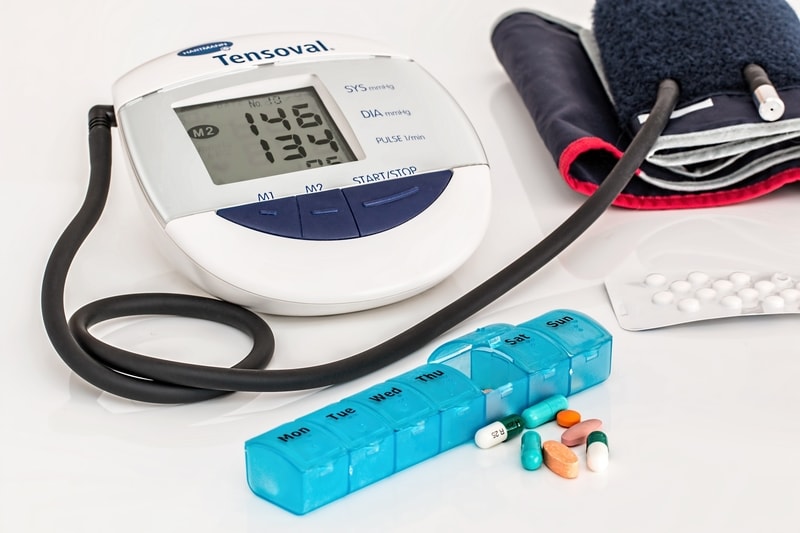Hypertension is the most important known risk factor for stroke. It is characterized by long-term increased blood pressure (BP) against the artery walls that may cause health problems, such as cardiovascular and cerebrovascular diseases. High blood pressure damages arteries throughout the body, creating conditions where they can burst or clog more easily. Weakened arteries in the brain, resulting from high blood pressure, increase the risk for stroke — which is why managing high blood pressure is critical to reduce the possibility of stroke occurence.
The classification of BP for adults aged 18 years or older is the following:
– Normal: Systolic lower than 120 mm Hg, diastolic lower than 80 mm Hg
– Prehypertension: Systolic 120-139 mm Hg, diastolic 80-89 mm Hg
– Stage 1: Systolic 140-159 mm Hg, diastolic 90-99 mm Hg
– Stage 2: Systolic 160 mm Hg or greater, diastolic 100 mm Hg or greater
Hypertension is defined as a systolic blood pressure (SBP) of 140 mm Hg or more, or a diastolic blood pressure (DBP) of 90 mm Hg or more, or taking antihypertensive medication. Hypertension may be primary, which may develop as a result of environmental or genetic causes, or secondary, which has multiple etiologies, including impairment of the kidneys, vascular or endocrine systems (adrenal gland tumors, thyroid diseases), obstructive sleep apnea, use of certain medications (birth control pills, cold remedies, decongestants, over-the-counter pain relievers and some prescription drugs) or misuse of illegal drugs, such as cocaine and amphetamines. Primary or essential hypertension accounts for 90-95% of adult cases, and secondary hypertension accounts for 2-10% of cases.
It is estimated that 26% of the world’s population (972 million people) has hypertension, and the prevalence is expected to increase to 29% by 2025. The high prevalence of hypertension represents a tremendous public health burden. As a primary contributor to heart disease and stroke, the first and third leading causes of death worldwide, respectively, hypertension was the top modifiable risk factor for disability adjusted life-years lost worldwide in 2013.
Certain risk factors contribute to development of hypertension, such as older age, male gender, black race, family history, obesity, reduced physical activity, use of tobacco, unhealthy diet (too much salt (sodium) and too little potassium), drinking too much alcohol, stress, chronic conditions (kidney disease, diabetes, sleep apnea) and pregnancy.
Hypertension may develop over many years and some people may have high blood pressure for years without feeling any symptoms. Some people with hypertension may have non specific symptoms such as headaches, shortness of breath or nosebleeds. However, even without symptoms, high blood pressure damages the blood vessels and increases the risk of stroke. That is why, regular measurement of the blood pressure, which is easily done, is recommended, in order to detect and treat high blood pressure. Blood pressure should be measured at least every two years starting at age 18 and in people aged over 40 years (or 18 -39 years with a high risk of high blood pressure), blood pressure measurement should be done every year. It should be measured in both arms to determine if there’s a difference. Appropriate-sized arm cuff should be used.
Management of hypertension includes use of antihypertensive drugs and healthy life-style. The goals is to reduce cardiovascular and renal morbidity and mortality, with the focus on controlling the systolic BP, as most patients will achieve diastolic BP control when the systolic BP is achieved. Regardless of therapy or care, hypertension will be controlled only if patients are motivated to stay on their treatment plan. It is important to remember: the lower your blood pressure, the lower your risk of stroke!
References:
1. Benjamin EJ, Blaha MJ, Chiuve SE, et al, for the American Heart Association Statistics Committee and Stroke Statistics Subcommittee. Heart disease and stroke statistics-2017 update: a report from the American Heart Association. Circulation. 2017 Mar 7. 135 (10):e146-e603.
2. Bosworth HB, Powers BJ, Olsen MK, McCant F, Grubber J, Smith V, et al. Home blood pressure management and improved blood pressure control: results from a randomized controlled trial. Arch Intern Med. 2011 Jul 11. 171(13):1173-80.
3. [Guideline] Mancia G, Fagard R, Narkiewicz K, et al. 2013 ESH/ESC Guidelines for the management of arterial hypertension. 23rd European Meeting on Hypertension & Cardiovascular Protection. Available at https://www.esh2013.org/wordpress/wp-content/uploads/2013/06/ESC-ESH-Guidelines-2013.pdf.
4. James PA, Oparil S, Carter BL, et al. 2014 Evidence-Based Guideline for the Management of High Blood Pressure in AdultsReport From the Panel Members Appointed to the Eighth Joint National Committee (JNC 8). JAMA. 2014;311(5):507–520. doi:10.1001/jama.2013.284427
5. Katakam R, Brukamp K, Townsend RR. What is the proper workup of a patient with hypertension?. Cleve Clin J Med. 2008 Sep. 75(9):663-72.
6. Kearney PM, Whelton M, Reynolds K, Muntner P, Whelton PK, He J. Global burden of hypertension: analysis of worldwide data. Lancet. 2005 Jan 15-21. 365 (9455):217-23.


